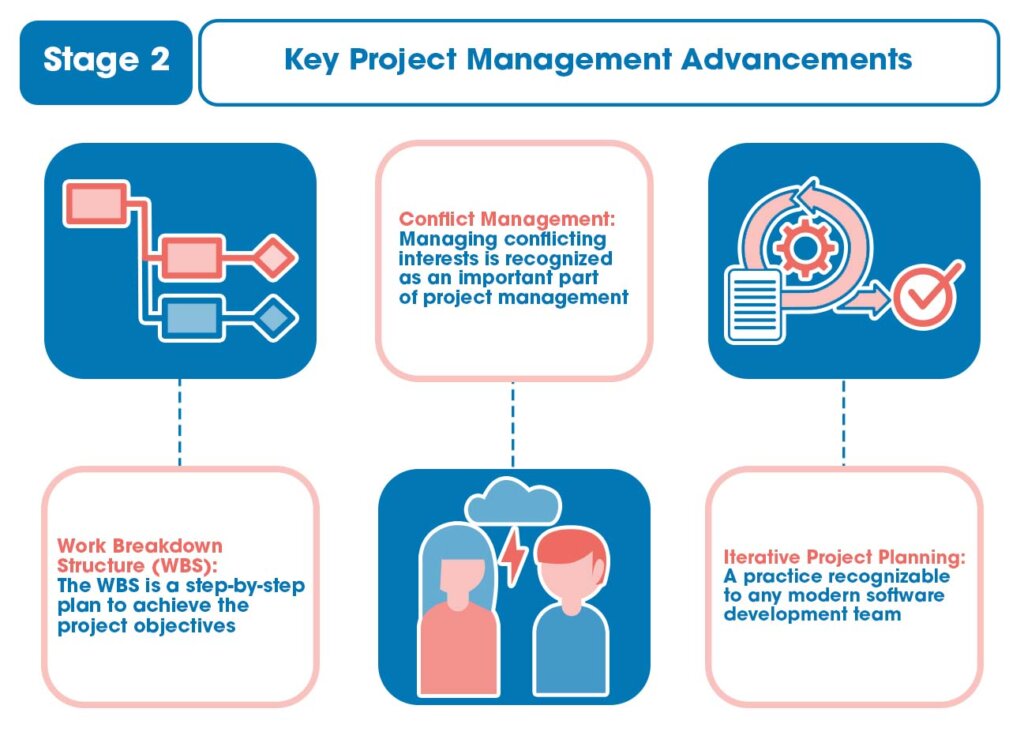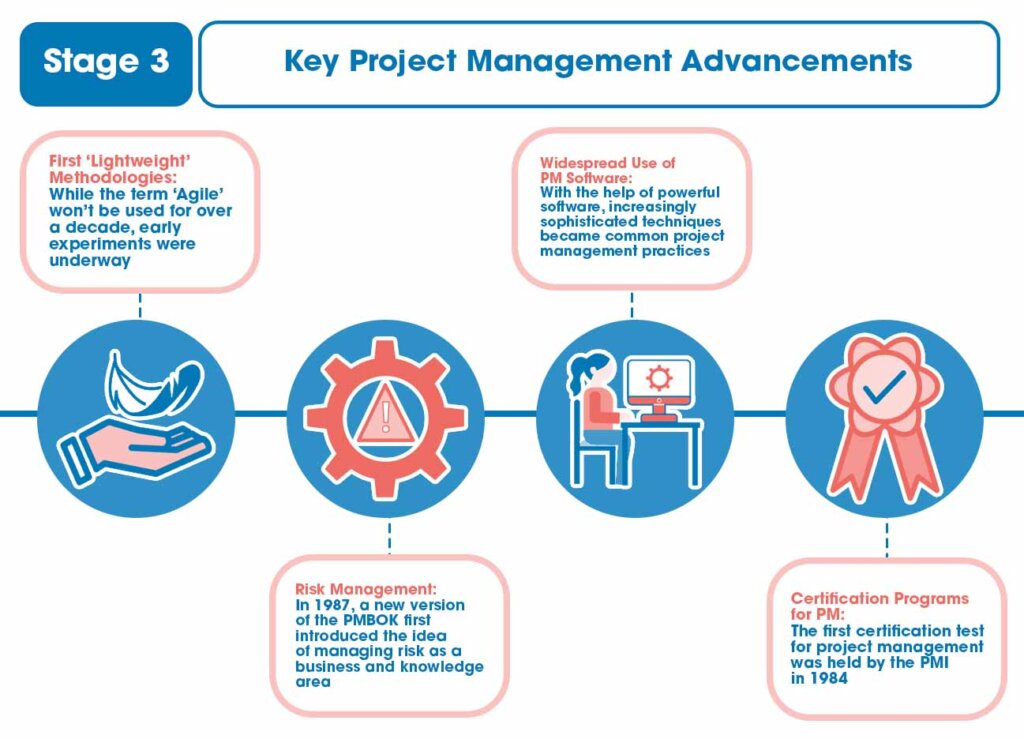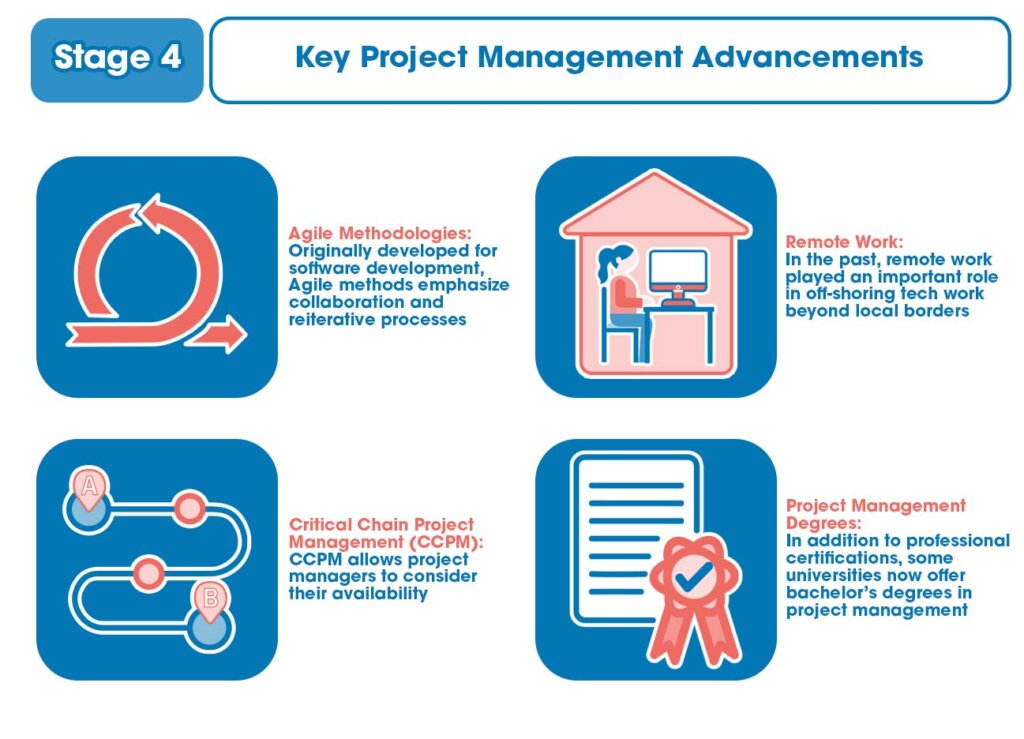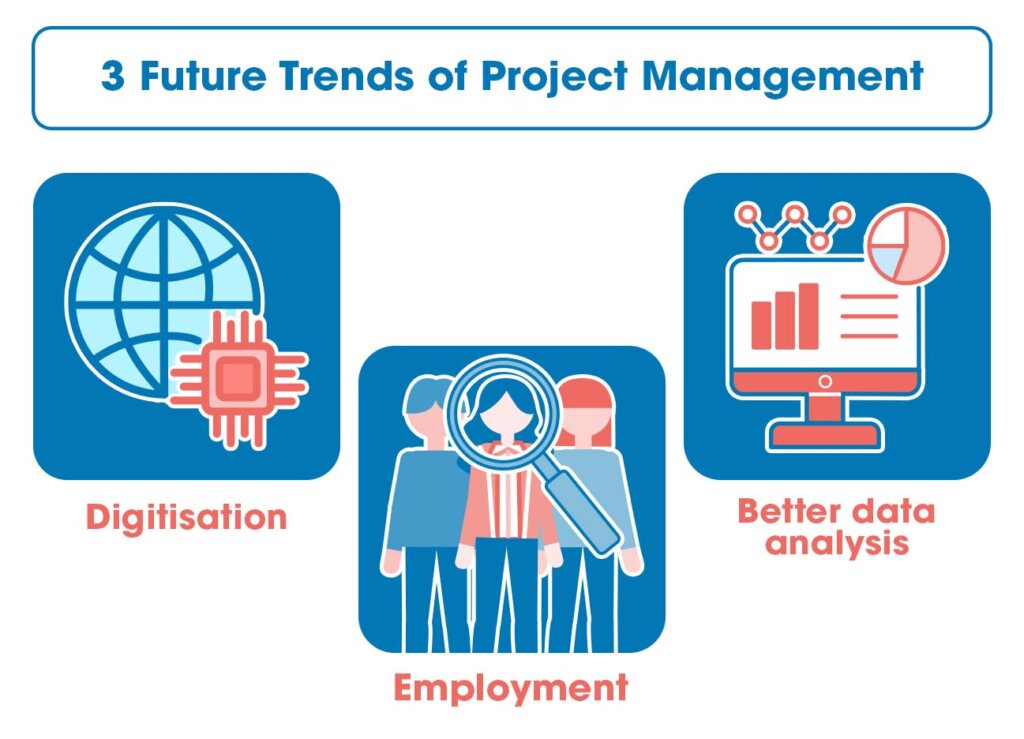In some ways, the history of project management is the history of the 20th century. It begins with Henry Gantt inventing his handy chart and continues through many of the most significant events in modern history. World wars, space shots, and the Internet all depended in some way on the development of project management.
Today, project managers may be more likely to be building a photo app than calculating ballistics. However, that may just be a testament to the ubiquitous usefulness of the techniques developed by past managers.
Try some of the best project management software for small businesses.
Key Takeaways: The History of Project Management
- There are four periods in project management history: Before 1958, 1958 to 1979, 1980 to 1994, 1995 to the present.
- Modern project management is considered to start in 1958, characterized by the development of CPM and PERT methods.
- Earlier project management innovations include the Gantt chart around 1910 and administrative work on the Manhattan Project.
- NASA and the Apollo programs contributed to the advancement of project management, mandating use of work breakdown structure, CPM, PERT, and other tools.
- Computer analysis was used in the 1970s, but became much more common in the 1980s and after.
- The first lightweight methodologies were developed in the 1980s in response to the growing needs of software developers.
- Agile Manifesto defined the values and principles underlying modern Agile methodologies.
The Four Historical Stages of Modern Project Management
The history of project management is broken into four stages of advancement. A quick look reveals that it’s a fairly brief history, with the first stage including all of human history prior to 1958. It’s around that year that the term ‘project manager’ was first used as we now do.
Before that, project managers couldn’t benefit from project management methodologies. Instead, it’s assumed the project’s success depended on random factors like the talent of individual project members or a particular project management style. Additionally, even large projects usually had one goal everyone focused on, making organization straightforward.
It’s safe to assume the areas project management focuses on have always been of interest, wherever or whenever you happen to be managing projects. However, it was the huge, multi-faceted projects of the cold war that first required modern methods.
Stage 1 (Prior to 1958)
While we could reach back to the projects which produced the Great Wall or the Pyramids, most histories look to the period around the two world wars for the first true project management techniques.
Henry Gantt popularized the Gantt chart only a few decades earlier in about 1910, allowing a new way to visualize projects. Modern mass production and construction, particularly combined with war efforts, led to more ambitious projects.
Throughout history, project management was considered just another skill, rather than its own discipline. However, historical projects like the Manhattan Project required a more organized approach for effective project management. Moreover, in many cases there was more depending on project success than a profit or deadline.
While there wasn’t anything we would consider a proper project management methodology, many tools we use were developed in this period. Innovators, both in government roles and private industry, created project management tools for their own use. They were then further tested and popularized in other projects.
Selected Key Advancements:

- Gantt Chart: A new way of visualizing tasks is by using Gantt charts which allowed project leadership to see relationships and project end dates. Introduced in the beginning of the 1900s, Gantt charts became popularized after use in the Hoover Dam and Interstate Highway projects.
- Precedence Diagramming Method: A visual way to outline the connections between tasks. The term used today is more often ‘action-on-node’ (AON) network. This method allowed mapping of predecessor-successor relationships throughout a project.
- Critical Path Method (CPM): One of several network analysis techniques, CPM is a ubiquitous project management tool. Using CPM, project leaders plan out the longest-duration path to estimate the project’s duration.
- Project Evaluation Review Technique (PERT): Another tool often used to manage projects, it was developed for use in such projects as the Polaris project and the space program.
Defining Projects:
- Manhattan Project: An iconic and successful project, it required a sprawling, multifaceted approach but was nevertheless vital. Project leadership had a purely administrative role, separate from any engineering or research duties.
- Polaris Project: The first submarine-launched nuclear missiles were developed by the Navy Special Projects Office early in the Cold War. On this project, tools like PERT analysis were developed by project managers to help manage schedules.
- Interstate Highway System: Construction of the highway system was one of many capital projects, in the USA and elsewhere, that were begun around this time. Adequate project progress required work to happen in many places at once, requiring tight organization.
Stage 2 (1958 to 1979)
Most historians agree the modern project management era began around this time. In 1965, Europe’s overarching project management body, the International Project Management Association (IPMA), was founded. Shortly afterwards, in 1969, the Project Management Institute was founded in North America.
The role of project manager was becoming more important in itself, rather than as part of the chief engineer’s job. The space program, including the Apollo moon-shot, was at its peak activity. Due to those projects and others, techniques like CPM and PERT continued to be developed.
Until the early 70s, project management was still applied primarily in defense, construction, and aerospace industries. It wasn’t yet seen as vital to managing successful projects. However, throughout the 70s it began to be applied more widely in other areas. The heavy use of tools like CPM formed an association between project management and systems analysis.
The 70s also saw the development of some tools we now considered essential, such as the work breakdown structure (WBS). Some early inkling of Agile concepts, such as working iteratively, could also be seen.
Selected Key Advancements:

- Work Breakdown Structure (WBS): Another indispensable tool, the WBS is a step-by-step plan to achieving the project objectives. Its use was mandated for government projects over a certain size, which likely led to its popularization.
- Conflict Management: Managing conflicting interests is recognized as an important part of project management. The adoption of matrix organizational techniques, among other things, made conflict management essential for good project outcomes.
- Iterative Project Planning: A practice recognizable to any modern software development team, iterative planning and development was used in some projects, for example, in the space program’s Project Mercury.
Defining Projects:
- Space Program and Apollo: Including some of the most significant projects in history, the space program relied heavily on project scheduling models and other project planning tools. Refinements on CPM, PERT, and the WBS were all used.
- ARPANET: First coming online in 1971, this network linking various learning and research institutions would form the basis of the modern Internet. Without specific project leaders, it was a collaborative effort.
Stage 3 (1980 to 1994)
In the 1980s, project managers began to develop new attitudes to project risk management. The methods used at that point usually referred to now as Waterfall methods often focused on resolving problems as they arose. That had led to project failures and increased cost, if not worse.
Instead, more time was spent planning complex projects from the start, using new methods to anticipate and avoid risks. At the same time, software engineering was becoming useful in every field. Software development projects might be very complex, but not have large administrative teams. Leaner methodologies started to be developed.
In 1981, the Project Management Institute released the Ethics, Standards, and Accreditation project report. It offered the first few project management process groups. In 1986, PMI would go on to issue an expanded version in the first edition of the PMBOK in an international journal, the Project Management Journal.
Selected Key Advancements:

- First ‘Lightweight’ Methodologies: While the term ‘Agile’ won’t be used for over a decade, early experiments were underway. For example, Scrum was introduced in 1986. Rapid Application Development was developed by 1991 and development of Crystal Methods began the same year.
- Risk Management: In 1987, a new version of the PMBOK first introduced the idea of managing risk as a business process and knowledge area. Focus on this area was prompted by the Challenger disaster and its design project failure.
- Widespread Use of PM Software: Large, mainframe computers were replaced by smaller personal models. With the help of powerful software, increasingly sophisticated techniques became common project management practices.
- Certification Programs for PM: The first certification test for project management was held by the PMI in 1984. Soon after, more stringent certifications were introduced internationally. Management science is formally recognized as a separate discipline, including sub-disciplines like program management.
Defining Projects:
- English-France Channel Tunnel: The Channel project was complex not only because of its international nature, requiring coordination of governments, financial institutions, and more. It also was complicated by multiple measuring systems, as well as the need to have two groups digging from opposite sides meet in the middle.
- Challenger Investigation: A project in itself, the aftermath of the Challenger disaster was primarily an investigation of another project’s failure. A focus on managing risk and quality assurance followed.
Stage 4 (1995 to Present)
The modern age is defined by the Internet, as true in project management as anywhere. The access and connectivity it allows have transformed methods for organizing and performing work. The project manager role is filled by a project management professional, a career specialist.
The demands of software development prompted the development of new ideas. As a result, in 2001 the Agile Manifesto was published, outlining a new philosophical approach. It brought earlier techniques together as the Agile project management method.
On a wider scale, project management ideas are now applied in corporate management. As a result, concepts from project management have begun to shape business strategy overall, benefiting strategic management. Additionally, a globalized economy means projects have to take multi-cultural considerations into account.
Selected Key Advancements:

- Agile Methodologies: Originally developed for software development, Agile methods emphasize collaboration and reiterative processes. Projects run using Agile methods are self-directed and deliver working products quickly.
- Remote Work: Recently, remote work allowed a significant increase in the work-from-home rate. Before that, it played an important role in off-shoring tech work beyond local borders. In many ways, team location is no longer a constraint.
- Critical Chain Project Management (CCPM): CCPM is a refinement of the ubiquitous CPM. Where CPM did not take resources into account, CCPM allows project managers to consider their availability.
- Project Management Degrees: In addition to professional certifications, some universities now offer bachelor’s degrees in project management.
Defining Projects:
- Y2K: As the year 2000 approached, it was realized fundamental software architecture wouldn’t be able to process dates starting with a two. Rather than a single project, Y2K was a tremendous number of parallel software projects around the world that often required coordination, sharing talent and resources.
- Panama Canal Expansion: As global trade increased, the Panama went from a vital passage to a chokepoint causing innumerable delays. The series of complex projects to widen and expand the canal, while simultaneously keeping it open to traffic, experienced delays and hiccups. Eventually costing over 5 billion dollars, it was finished over a year late.
- Large Hadron Collider: With a project lifecycle extending over half a century, LHC construction faced a number of challenges. Funding came from multiple governments. Gathering project requirements involved ongoing research.
The Future of PM
The role of the project manager will continue to be redefined in future projects. Some predict that three trends will support more sophisticated use of PM methods in every aspect of life. Those trends are:

- Digitization.
- Employment.
- Better data analysis.
While the role of project manager tended toward increased specialization in the past, modern project management tools have become widely available. As a result, project management may become a universally integrated process once more, to some extent part of everyone’s job.
Digitization
The transition from a paper-based society to a digital one is going to continue. While that makes tremendous amounts of potentially useful information available, picking out only the useful bits can be very difficult. Storing and accessing all that information also becomes a challenge a successful project must address.
Cloud storage allows for easily scalable IT infrastructure. Machine learning tools help manage that information, while modeling by artificial intelligence may aid in decision making.
Employment
Not only is the project manager’s role evolving, but the job of the project team is changing as well. AI, robotics, 3D printing, and other technological advances could perform a lot of repetitive, low-level tasks. Ideally, that would free people up to focus on the more creative aspects.
Additionally, work will become increasingly transnational. People in geographically distant locations can collaborate meaningfully in real-time. Management practices will have to take those changes into account. At the same time, local issues will always have an influence.
Better Data Analysis
Digitizing information means it can be analyzed and assessed easily using powerful computer tools. Study and statistics will reveal in more detail the factors that lead to projects failing and those that ensure project success.
Data analysis may also reveal ways to reduce project costs and more efficiently manage project activities. Doing so in earlier project management phases can help avoid problems later.
Frequently Asked Questions (FAQs) for The History of Project Management
Final Thoughts on The History of Project Management
With its roots in the great events of the recent past, it seems likely project management will have a profound effect on how we live in the future. It turns out some of the same management tools used in building missiles can also help you write your next paper.

